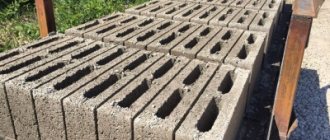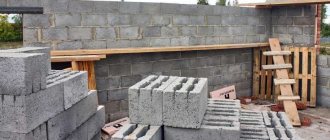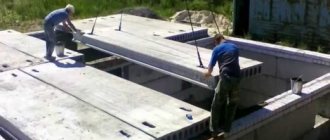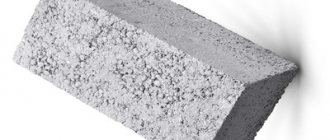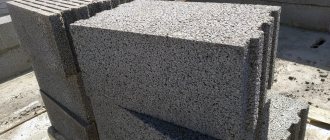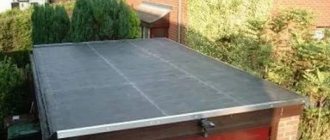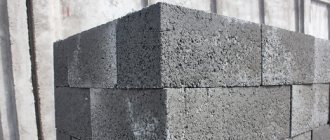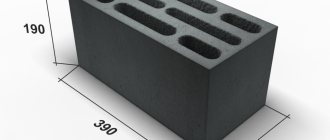Expanded clay concrete blocks have proven themselves well in construction. Good cost savings and quick installation are some of the advantages of this material. The information provided on which expanded clay concrete blocks to use for load-bearing walls is given based on low-rise construction in the private sector, subject to the condition of a correctly laid foundation. Recommendations are subjective and based on personal experience.
The choice of expanded clay concrete blocks is based on several factors:
- Building height;
- Type of floors;
- Purpose of the structure;
- Climatic conditions of the external environment;
- Laying method;
- Aesthetic perception.
For the construction of low-rise buildings, expanded clay concrete products are used, differing in the type of concrete:
- Construction blocks;
- Structural and thermal insulation blocks;
- Thermal insulation blocks.
It is prohibited to use heat-insulating blocks in load-bearing walls. Only for the purpose of insulation.
There are technical aspects of choosing expanded clay concrete products:
- Compressive strength;
- Frost resistance;
- Medium density;
- Thermal conductivity;
- Water absorption;
- Color.
Mechanical strength of blocks
The mechanical strength of expanded clay concrete blocks determines how high a building can be built. The floors used in the building determine the grade of compressive strength of the expanded clay concrete product. Compressive strength is a parameter showing how much pressure a block can withstand before breaking, measured in kilograms/cm2. The number after the letter M means the number of kilograms per 1 cm2.
The compressive strength of products is classified by brand and class. Brands are designated by the letter M, classes by the letter B: M5, M10, M15, M25, M35, M50, M75, M100, M150 (B10), M200 (B15), M250 (B20), M300 (B22.5), M350 (B25 ), M400 (B30), M450 (B35), M500 (B40).
The strength of blocks from the manufacturer may immediately differ from those declared. The compressive strength should be less than the parameters presented below.
During the warm season:
- 80% for products of brands 100 and below;
- 50% for products of brands 150 and above.
In the cold season, the actual strength may be:
- 90% for products of brands 100 and below;
- 70% for products of brands 150 and above.
Within 28 days of the block from the date of manufacture, the product must achieve the declared strength.
Expanded clay concrete blocks of the M25 grade are not used at all for load-bearing walls. Blocks of the M35-M50 brand can be used in one-story buildings with wooden floors.
Features of M75 brand mixtures
This masonry mixture is second in the strength rating of building mixtures, ahead only of M50 mortar (class B 3.5). The final characteristics of the mixture depend on the quality of the raw materials, but they will still be inferior to BST, since the base of the solution includes a small volume of cement, as well as coarse sand. Sandstone, like the water included in the composition, undergoes thorough cleaning, which eliminates the risk of accidental ingress of organic or chemical impurities. In addition to the mentioned components, the composition includes solid aggregate (crushed stone) of a coarse fraction. Precise selection of grain size makes it possible to improve the mobility and workability of the solution.
Although the cement-sand mixture TsPS M75 is not used in critical areas, its quality should also not be neglected. It largely depends on the correct composition and compliance with mixing proportions. To avoid mistakes when preparing building materials, you need an understanding of how individual components interact with each other, as well as high-precision weighing equipment. All this is at the disposal of RBU, which employs technologists who have passed strict qualification selection. The plant itself is equipped with a European-made BSU, as well as automated underfill protection systems.
Frost resistance
Frost resistance is standardized for products used in the laying of load-bearing walls and fences. Frost resistance is the block’s resistance to freezing. It is frost resistance that determines the reliability and long-term operation of expanded clay concrete products. After the letter F, the number indicates the number of cycles of complete freezing and thawing, without compromising strength. According to frost resistance, products are divided into brands: F15, F25, F35, F50, F75, F100, F150, F200, F300, F400, F500.
For load-bearing walls, it is necessary to take products with a frost resistance grade of at least F50.
Specifications
When deciding whether M75 cement mortar is suitable for specific work, you need to take into account the following parameters of the finished mixture:
- strength - corresponds to class B5;
- frost resistance - F50;
- maximum permissible loads - 65.5 kgf/cm²;
- moisture resistance - W2;
- mobility - P2-P4;
- density - 1800 kg/m³.
A structure made from this material will withstand only 50 freezing and thawing cycles, and therefore it is not recommended for installation in areas with an unstable climate. Low moisture resistance makes the material unsuitable for creating elements that are in constant contact with water. The stated characteristics can be slightly improved by the manufacturer himself by adding plasticizers and modifiers to the composition.
Average density is the weight of the product.
The required block density should be no more than D2000. After the letter D is the mass value in kilograms per cubic meter. That is, 1 m3 of structural insulating blocks labeled D600 will weigh 600 kg.
As an example, the marking of expanded clay concrete products for load-bearing walls KBSL-50-M25-F35-D600 GOST is given. According to the information above, it is easy to decipher - expanded clay concrete wall block 500 mm long, compressive strength 25 kg/cm2, frost resistance 35 cycles and weight per cubic meter 600 kg.
The weight of the product depends on its design. Hollow products usually have a tensile strength of M35-M50.
The outer wall of the hollow block should be no thinner than 20 mm.
There are reinforced hollow products with a wall thickness of 40mm. Standard characteristics of M75-F50-D1050. They are recommended for load-bearing walls up to 3 floors.
In self-supporting walls with concrete floors for which high loads are planned, solid blocks of density D1100 - D1800, strength M100 - M500 and having high frost resistance of F50 are used.
To reduce the weight of the wall, combined masonry is used. For the front side they take facing expanded clay concrete products with a tensile strength of M35, and as an ordinary solid block M100. The result is not only a reduction in weight, but also a reduction in heat loss.
Brand of cement mixture M75
Although the mortar is inferior in strength, moisture and frost resistance to heavier analogues, it also has a number of its advantages: the M75 cement mortar has a low cost, and it is also slowly cemented, which helps to quickly correct detected flaws and shortcomings.
To ensure that the result meets your expectations, order building materials from manufacturers responsible for product quality. These include the RBU network in the Moscow region, where they will help you arrange the delivery of masonry mixture to any locality in the region.
Thermal conductivity of the material
Expanded clay concrete products, for external walls, thermal conductivity is standardized. The thickness of the walls depends on the thermal conductivity of the material. Below is part of the table for residential and domestic buildings and structures, without correction factors, on the basis of which you can independently calculate the depth of the wall made of expanded clay concrete blocks.
Standardized values of heat transfer resistance of walls R m2? S/W
| Type of building, structure | Degree-day of the heating period D C?day | |||||
| 2000 | 4000 | 6000 | 8000 | 10000 | 12000 | |
| Residential | 2,1 | 2,8 | 3,5 | 4,2 | 4,9 | 5,6 |
| Household with damp or wet mode | 1,8 | 2,4 | 3,0 | 3,6 | 4,2 | 4,8 |
Full table data with correction factors and calculation rules can be found in SNiP 02/23/2003.
Degree-days D can be roughly calculated independently:
The mathematical difference between the recommended indoor temperature and the average daily outdoor temperature during the heating period is multiplied by the number of days of the official heating period. The result obtained is rounded within the table.
Wall thickness:
Based on the table data, we multiply the resistance coefficient R by the thermal conductivity of the block. The result obtained is the depth of the wall.
For example, degree-day D for Krasnodar is 2380?2000, respectively, heat transfer resistance R -2.1. There is an expanded clay concrete block M50-F50-D950 dimensions 380?190?188 thermal conductivity 0.19-0.26 W/m C. We get 2.1?0.26=0.546 m. The width of the wall will be one and a half blocks.
The thermal conductivity of the expanded clay concrete block in the masonry increases, so in the calculations we take the maximum value.
What are expanded clay concrete blocks according to GOST
Expanded clay concrete is classified as lightweight concrete. A porous material, expanded clay, is used as a filler. These are round granules made of baked clay. The composition of expanded clay concrete is cement, sand, expanded clay and water. When preparing the mixture, more water is poured than in ordinary heavy concrete, since expanded clay is hygroscopic and absorbs liquid. When producing blocks, the finished mixture is poured into molds, left until initial hardening, after which they are removed from the mold. In principle, the blocks are ready, but they cannot be used until they reach their design strength.
A house made of expanded clay concrete blocks can be built quickly
There are two technologies for bringing products to normal strength at the factory - in an autoclave and by vibration pressing. In the first case, the blocks are sent to an autoclave, where the material is treated with steam under pressure. This makes expanded clay concrete blocks more durable. The second method is vibration with simultaneous pressure. When vibrating, all voids disappear, the solution becomes more homogeneous and fluid, enveloping each of the expanded clay granules. The result is high strength indicators.
In artisanal production, the blocks are simply left to “ripen.” In theory, it takes at least 28 days until the concrete gains strength. But they can sell it earlier so as not to take up space. Nobody guarantees durability.
Round granules of expanded clay can be seen on the surface of the block. Depending on the brand, they can be of different sizes, in larger or smaller quantities
The fact is that for cement to gain normal strength, it is necessary to create a certain heat and humidity regime. In this regard, expanded clay concrete is more capricious than ordinary concrete. Due to the high absorption capacity of expanded clay, it can take up too much water. And the liquid will not be enough for the concrete stone to gain strength and not just dry out. Therefore, it is advisable to water the finished blocks and cover them with film at least for several days after production. They cannot be kept in the sun and the temperature should not be lower than +20°C. Otherwise, expanded clay blocks will never gain the required strength and will crumble even under light loads and impacts.
When it comes to price, factory units are more expensive. But still. If you are building a house, and not a utility block or barn, you should not save money and buy “garage”-made blocks. Quality is a big question here.
Color spectrum
The color can be any. It matters only when facing a building and depends on the aesthetic perception of the owner.
The criteria by which it is necessary to select expanded clay concrete blocks for load-bearing walls are mechanical strength, frost resistance and weight. Thanks to modern heat-insulating materials, heat loss can be reduced without increasing the thickness of the wall. Blocks with technical characteristics from:
- M35 to M100
- F50 to F100
- D 600 to D1400
It is advisable to use for load-bearing walls in low-rise private construction.
Expanded clay concrete - advantages and disadvantages
The quality of a building material can only be assessed by comparison. For some parameters, we will compare expanded clay concrete with its closest competitor, aerated concrete.
Advantages of expanded clay concrete when building a house
- High strength. The material provides high structural properties of the building. For a private house of small height, this parameter is not so important, so the benefits are more of a psychological effect.
- Less fight during shipping and handling. Compared to aerated concrete, expanded clay blocks are more difficult to damage or break.
- Slow absorption of moisture. Expanded clay blocks do not absorb moisture as quickly as aerated concrete does.
- Low shrinkage. Because of this, there is no need to install reinforcing belts in the masonry, as is necessary with aerated concrete. Expanded clay block - 0.3 mm/m, aerated concrete - 0.4 mm/m.
- High resistance to cracks. Foundation movements are less likely to lead to cracks on an expanded clay concrete wall.
Disadvantages of expanded clay block when building a house
- Relative difficulty of performing the work. Compared to aerated concrete, laying expanded clay products will require more time. Sustaining a thick seam of 8 - 12 mm requires more experience from the performer. In addition, expanded clay concrete itself is heavier than most stone wall materials.
- Longer construction time. Expanded clay concrete slowly absorbs water, but it takes a long time to release it. After production and during construction, products accumulate moisture, so after completion, time must pass before subsequent work. On average, a structure made of expanded clay concrete blocks will take longer to dry than aerated concrete.
- The inability to use thin-layer masonry leads to increased consumption of cement-sand mortar.
- The need for insulation. The thermal resistance of a wall made of expanded clay concrete does not meet the requirements for the thermal resistance of enclosing structures. For this reason, the house will need to be additionally insulated from the outside.
Insulation with vapor-proof materials can only begin after the structure has dried.
- Difficulty of processing. The blocks consist of small expanded clay granules, which can break off when sawing. In general, the material is quite hard, so it cannot be processed with a saw; for even cutting you will need a grinder.
- Thick finish. The facade made of expanded clay concrete looks unattractive, so the top of the house should be plastered. Since the material does not have a smooth surface, it is first necessary to carry out a “rough” leveling and only then a “finish” leveling. In this case, the plaster layer cannot be less than 10 mm. Additionally, the wall must be reinforced with mesh.
- Strong wind blowing. Expanded clay aggregate has a heterogeneous structure with pores of different sizes. This affects the ventilation of the house; for this reason, a wall made of expanded clay concrete must be plastered.
Features of types of bricks
But strength and frost resistance are not the only important characteristics for brick. In addition, the composition of the material also plays a big role. For example, sand-lime brick absorbs moisture better, so it is perfect for the construction of plinths and foundations. If the area is “wet” or the groundwater is shallow, sand-lime brick is not recommended. However, it is simply perfect for the construction of interior partitions, since the material has a high noise absorption coefficient.
Clinker brick has high frost resistance and strength grade. It is also characterized by a richly colored surface and an attractive appearance; it is not for nothing that it is a type of decorative. However, these phenomenal performance characteristics and beauty also have a downside - high cost. In addition, the material has high thermal conductivity, so it requires additional thermal insulation.
Hyperpressed brick is used for decorative finishing and cladding. It does not consist of clay, but of a mixture of water, cement and lime. It is durable and frost-resistant, but appeared relatively recently. Therefore, no one knows exactly what will happen to buildings made from hyper-pressed bricks in 20-30 years. Also, such material has a high specific gravity, so buildings with it require a reinforced monolithic foundation.
Fireclay brick can also boast strength and frost resistance in equal measure. However, the scope of its use is narrower - the construction of barbecues, stoves, fireplaces, industrial heating units and chimneys. In addition, it is quite expensive.
In conclusion, we note that ceramic brick combines optimal characteristics - strength, long service life, frost resistance, etc. Thanks to modern technologies, it can have different colors and surface textures. Everyone will choose something for themselves. The most important thing is that the material is of high quality.
Brick brands and their characteristics
The brand of brick often depends on the raw materials, as well as the method of production of the material. Ceramic brick can have a strength grade of M-50, M-75, M-100, M-125, M-150, M-200, M-250, M-300. Frost resistance is equal to F-25, F-30, F-50 and F-150.
Sand-lime brick has strength grades M-75, M-100, M-125, M-150, M-200, M-250, frost resistance F-15, F-20, F-25, F-30 F-35, F 40, F-45, F-50.
In clinker bricks, these indicators are M-200, M-300, M-350, M-500, M-1000 and F-100, F-200, F-300, respectively.
Hyperpressed brick has strength grades M-50, M-75, M-100, M-125, M-150, M-200, M-250, M-300. F-100, F-200, F-300 Frost resistance is F-25, F-50, F-100, F-150, F-200.
The strength grades of refractory fireclay bricks are M-75, M-100, M-125, M-150, M-200, M-250, M-300, M-350, M-400, M-450 and M-500 . Frost resistance is F-25 or F-50.
Price of masonry mortar brand M75 in Moscow
Solutions of this brand comply with GOST 28013-98 standards. This quality can be achieved by using selected raw materials, which cannot be budget-friendly. However, direct cooperation with suppliers, as well as low cement content, helps reduce the cost of the finished material, which has a positive effect on the construction budget.
If you want to calculate the cost of supplying M75 cement mortar, use the price lists that are posted on the pages of the official RBU website, or contact the plant managers. Typical prices shown include VAT but do not include delivery costs.
Delivery of cement mixture from 1 m³
You can order M75 masonry mortar to any part of the Moscow region. The required amount of material will be delivered on the day of the application using the ABS plant. Mixers hold from 7 to 12 m³, and therefore prompt shipment of even large batches of material is possible.
RBU is located next to the main transport arteries of the Moscow region, which helps reduce delivery times and optimize associated costs. Applications are accepted 24 hours a day, 7 days a week, and plant employees carefully monitor compliance with deadlines and other agreements.
